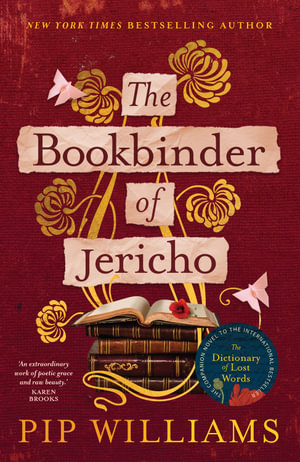The bookbinder of Jericho by Pip Williams

What is lost when knowledge is withheld, is a cornerstone question which permeates Pip William's new book, The bookbinder of Jericho.
Set during World War One, the lives of twins Peggy and Maude are changed in ways they could never have predicted. Clever, outspoken Peggy has watched out for her sister since their mother died when they were seventeen. Peggy often recalls her mother’s words which help her see Maude without criticism, helping her understand the world she inhabits.
The twins work in an Oxford University bindery, in a team of girls who bind together the pages into a new book, a laborious procession of folding pages accurately, tapping them together, stitching, then sending them on to be covered by the men. Peggy looks wistfully at the books she puts together, always on the alert for a rejected copy, taking it home to store in the narrow boat, to be read then added to the collection started by her mother.
Into their world comes a group of Belgian refugees, then wounded soldiers, each group requiring the girls and the readers to question their beliefs about the war.
Peggy joins a volunteer group who read and write letters for the hospitalised soldiers. She learns to love one soldier, his face blown apart, as she guides him out from his self imposed solitude and despair. One of the refugees, Lot becomes close to Maude, noting her differences, paralleling her own dead son. The story is framed by major events during the war as we hear of the Gallipoli campaign, the Somme, the Belgian towns where families were slaughtered, Etaples and Armistice, peace and going home. These events impact the Jones family as they hear of the front through letters from mother’s friend, Tilda, joining as a VAD but becoming more useful in the field surgeries’ tent where she sees things she cannot unsee. Other people around the Jones family come and go, some of the men who joined up not returning, those who do come back, shattered by their experiences. They wait for letters, each eagerly read and shared, each adding another aspect of the war both at the front and at home.
All the while, Peggy develops a strong friendship with Gwen, who pushes her to think about getting an education, but Peggy is hesitant, feeling she must look after Maude.
Peggy is a town girl, working for her living, Gwen a gown, studying at the university, and between the two we see the great divide in society, not only between women and men but between the classes.
The relationship between Peggy and Bastian comes to a head, forcing Peggy to make decisions about her future.
She has failed in her attempt to join Summerville as an undergraduate and feels defeated. The readers wondering whether she would rally to try again.
The writing of this book is wonderful, making it an easy read seamlessly incorporating new information about bookbinding, encouraging the reader to take another look at the book they are holding, sensing the enormous changes that technology has wrought.
Nods to her previous book The dictionary of lost words are given through the characters of Esme and Gareth and the City of Oxford and the town and gown divide is clearly represented in the new characters. The fight for women’s suffrage roams behind the scenes, and Peggy’s attempts to be admitted to university exemplifies the fight that society is undertaking.
A short interview with Pip Williams can be found here. And this is followed by a clip of Pip showing the ways the bindery worked.
Themes: Social class, World War One, Oxford, Printing, Book binding, Amputation, Spanish flu, Women's suffrage.
Fran Knight